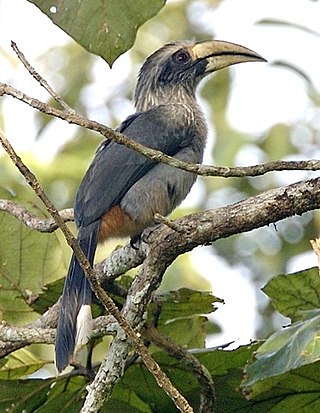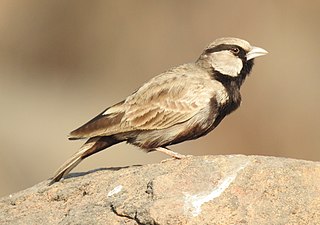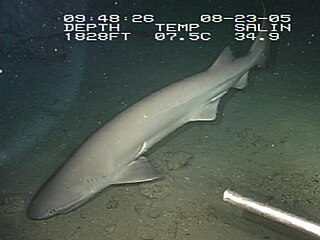
Risso's dolphin is a marine mammal and dolphin, the only species of the genus Grampus. Some of the most closely related species to these dolphins include: pilot whales, pygmy killer whales, melon-headed whales, and false killer whales. These dolphins grow to be about 10 ft in length and can be identified by heavy scarring that appears white. They are located worldwide in cold to temperate waters, but most typically found along continental shelves due to their eating habits. Risso's dolphins have a diet that contains primarily cephalopods. They are able to search for prey at various depths due to their ability to reach depths of almost 600m. Individuals typically travel in pods ranging anywhere from 10 to 50 dolphins, with which they form tight social bonds.

The short-billed dowitcher, like its congener the long-billed dowitcher, is a medium-sized, stocky, long-billed shorebird in the family Scolopacidae.

The western gray squirrel is a tree squirrel found along the western coast of the United States and Mexico. In some places, this species has also been known as the silver-gray squirrel, the California gray squirrel, the Oregon gray squirrel, the Columbian gray squirrel and the banner-tail. There are three geographical subspecies: Sciurus griseus griseus ; S. g. nigripes ; and S. g. anthonyi.

The Malabar gray hornbill is a hornbill endemic to the Western Ghats and associated hills of southern India. They have a large beak but lack the casque that is prominent in some other hornbill species. They are found mainly in dense forest and around rubber, arecanut or coffee plantations. They move around in pairs or small groups, feeding on figs and other forest fruits. Their loud cackling and laughing call makes them familiar to people living in the region.

The ashy-crowned sparrow-lark is a small sparrow-sized member of the lark family. It is found in the plains in open land with bare ground, grass and scrub across South Asia. The males are well marked with a contrasting black-and-white face pattern, while females are sandy brown, looking similar to a female sparrow. Males are easily detected during the breeding season by the long descending whistle that accompanies their undulating and dive-bombing flight displays.

The white-eyed vireo is a small songbird of the family Vireonidae.

The northern grey-headed sparrow, also known as the grey-headed sparrow, is a species of bird in the sparrow family Passeridae, which is resident in much of tropical Africa. It occurs in a wide range of open habitats, including open woodlands and human habitation, often occupying the same niche as the house sparrow does in Eurasia.

The genus Sciurus contains most of the common, bushy-tailed squirrels in North America, Europe, temperate Asia, Central America and South America.

The bluntnose sixgill shark, often simply called the cow shark, is the largest hexanchoid shark, growing to 20 ft (6.1 m) in length. It is found in tropical and temperate waters worldwide and its diet is widely varied by region.

The South American gray fox, also known as the Patagonian fox, the chilla or zorro gris, is a South American species of Lycalopex in the Canidae family, which includes dogs, wolves, jackals, coyotes and foxes, among other canids. It is endemic to the southern parts of Argentina and Chile, primarily Patagonia and Tierra Del Fuego.

The desert monitor is a species of monitor lizard of the order Squamata found living throughout North Africa and Central and South Asia. The desert monitor is carnivorous, feeding on a wide range of vertebrates and invertebrates.

The mangrove snapper or gray snapper is a species of snapper native to the western Atlantic Ocean from Massachusetts to Brazil, the Gulf of Mexico, Bermuda, and the Caribbean Sea. The species can be found in a wide variety of habitats, including brackish and fresh waters. It is commercially important and is sought as a game fish. It can also be found in the aquarium trade.

The Chinese striped hamster, also known as the striped dwarf hamster, is a species of hamster. It is distributed across North Asia from southern Siberia through Mongolia and northeastern China to northern North Korea. An adult Chinese striped hamster weighs 20 to 35 g, and has a body length of 72 to 116 mm with a tail of 15 to 26 mm. It is smaller and has a much shorter tail than the greater long-tailed hamster, Tscherskia triton, which inhabits much of the same range.

The gray flying fox is a species of flying fox in the family Pteropodidae. It is not to be confused with the Grey-headed flying fox. It is found in Indonesia, but not in the Philippines, despite occasional reference to such. Very little is known about this species. The gray flying fox has small size and neutral coloration with a brownish head and an orange abdomen. It probably roosts individually or in small groups. It was listed on appendix II of CITES, and is classified as "Data Deficient" by the IUCN. This species has been decimated by hunting for bushmeat in Indonesia. The hunters use fishing hooks, ropes, and other supplies to hunt the bats. The ropes and hooks are placed along their flight paths, tearing and ensnaring the bats' wings when are flying. In the course of a hunting season, entire colonies can be killed.

Ceanothus griseus is a species of flowering shrub known by the common names Carmel ceanothus and Carmel creeper. 'Carmel' refers to the Carmel-by-the-Sea region in California.

Streptomyces griseus is a species of bacteria in the genus Streptomyces commonly found in soil. A few strains have been also reported from deep-sea sediments. It is a Gram-positive bacterium with high GC content. Along with most other streptomycetes, S. griseus strains are well known producers of antibiotics and other such commercially significant secondary metabolites. These strains are known to be producers of 32 different structural types of bioactive compounds. Streptomycin, the first antibiotic ever reported from a bacterium, comes from strains of S. griseus. Recently, the whole genome sequence of one of its strains had been completed.

The Chinese goral, also known as the grey long-tailed goral or central Chinese goral, is a species of goral, a small goat-like ungulate, native to mountainous regions of Myanmar, China, India, Thailand, Vietnam, and possibly Laos. In some parts of its range, it is overhunted. The International Union for Conservation of Nature has listed it as a "vulnerable species".

Stenocereus griseus, also known as the Mexican organ pipe, dagger cactus, pitaya, and pitayo de mayo, is a species of cactus.
Grass bagworm is a common name for several insects and may refer to:

Varanus darevskii, also known as the Central Asian monitor, is an extinct species of monitor lizard from the Early Pliocene of Tajikistan, known from a partial skull. V. darevskii might have been a close relative of, and perhaps ancestral to, the modern desert monitor.




















